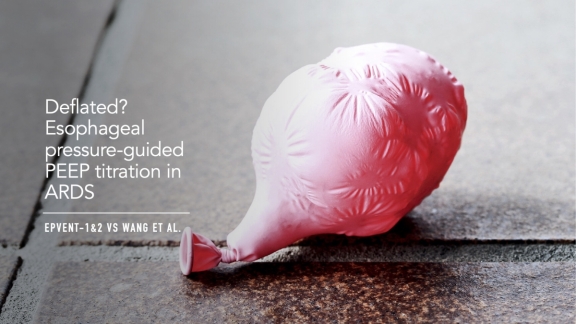#EMConf- TTM Journal Club
Article: Targeted Temperature Management for Cardiac Arrest with Nonshockable Rhythm
Article: Targeted Temperature Management for Cardiac Arrest with Nonshockable Rhythm

Lung protective ventilation limiting tidal volume and plateau pressure improves survival in ARDS. The application of positive end-expiratory pressure (PEEP) further stabilizes the lung by preventing alveolar collapse during expiration, thereby reducing cyclic atelectasis. However, the optimal approach to PEEP titration to minimize ventilator-induced lung injury (VILI) has not been delineated. The EPVent-1 trial demonstrated that esophageal pressure-guided PEEP titration was feasible and safe with a trend toward increased survival and improved oxygenation in mild to moderate ARDS. However, interest in esophageal manometry in ARDS was deflated by the more recent EPVent-2 trial demonstrating no improvement in a composite outcome incorporating mortality and ventilator-free days in patients with moderate to severe ARDS. A new randomized control trial published last week by Wang et al. examined the role of esophageal manometry-guided PEEP titration in a novel subset of severe ARDS patients treated with VV ECMO.
A 46 year old woman arrives at the ED with hives, hypotension, difficulty breathing, and stridor after eating dinner with her family. She is allergic to shrimp, and thought she had avoided it when she ordered from her favorite restaurant. However, shrimp dishes are on the menu and she wonders if there was cross contamination. Unfortunately, she couldn’t find her epinephrine auto-injector at home so her family drove her to the ED. Immediately recognizing anaphylaxis, you give her a dose of IM epinephrine and she improves within several minutes. After seeing she has stabilized, you wonder how long should she be observed and what the evidence is behind the use of antihistamine and glucocorticoid therapy.
We do not often give thought to the factors controlling our circadian rhythm. And yet the circadian system modulates many physiologic systems, including brain arousal, cardiovascular function, sympathetic tone, appetite, metabolism and immune system function. Similar to the sinoatrial node pacing the heart, the suprachiasmatic nucleus located in the hypothalamus serves as the central pacemaker for the circadian rhythm, directing sleep, motor activity, temperature and autonomic tone. Rhythmic release of melatonin from the pineal gland helps drive this central clock in addition to other circadian biomarkers, including cortisol and core body temperature. In healthy individuals, plasma melatonin concentrations typically measure 10-fold higher at night than during the daytime. How does critical illness affect circadian rhythm, specifically melatonin secretion?
A 72 y/o male with PMH type 2 diabetes, CAD, HFrEF, HTN, and HLD is admitted to the MICU for frequent neurologic monitoring after an endovascular thrombectomy for an acute ischemic stroke caused by thrombosis of the M2 branch of the left MCA. While reviewing his chart, you notice that the patient was recently admitted for 1 week about 10 days ago for dyspnea secondary to acute decompensated heart failure. You also note on his admission labs that he is newly thrombocytopenic, with a platelet count of 80,000. His last platelet count on discharge was 250,000, and he has never been thrombocytopenic before. What is causing his thrombocytopenia?
A 52-year-old man with a history significant for hypertension presented to the emergency department with cough, dyspnea and fever. He progressed to severe acute respiratory distress syndrome (ARDS) secondary to COVID-19 pneumonia. He developed refractory hypoxemia with P/F < 60 mm Hg despite low tidal volume ventilation, paralysis, inhaled epoprostenol and prone positioning. Is this patient a candidate for venovenous ECMO and, if so, who should guide initiation and management of ECMO? The Society of Critical Care Medicine (SCCM) and Extracorporeal Life Support Organization (ELSO) recently published a position paper on the role of the intensivist in the initiation and management of ECMO.
It’s been a busy day in the ED and you’ve had several cardiac arrests come in back to back. EMS calls in with another one just as they’re hitting the door. The patient is an adult, but you notice the BVM they’re using is much smaller than what you’re used to seeing. The medic says “The day has been so bad, we didn’t have time to get back to base to restock the rig. We only had a pediatric BVM.” Knowing that safe ventilation includes limiting tidal volumes and pressures, you wonder what the implications of using a pediatric BVM are.
As we learn more about the pathophysiology of COVID-19, alternative treatments are being explored for the severe sequelae of this disease. SARS-CoV-2 enters human cells via the ACE2 receptor, located in many organs, including the heart, vascular endothelium, and alveolar epithelium causing an inflammatory cascade that can lead to ARDS, vasodilatory shock, myocarditis, acute kidney injury and capillary leak. Given the relationship between SARS-CoV-2 and the RAAS, is there a role for angiotensin II in vasodilatory shock caused by COVID-19?
A recent review article covered the top 10 EBM interventions to promote night shift alertness.
What is airway pressure release ventilation (APRV)? Here is a simplified breakdown of the ventilator settings, pressure and flow waveforms.
Copyright © 2024,
Designed by Zymphonies
